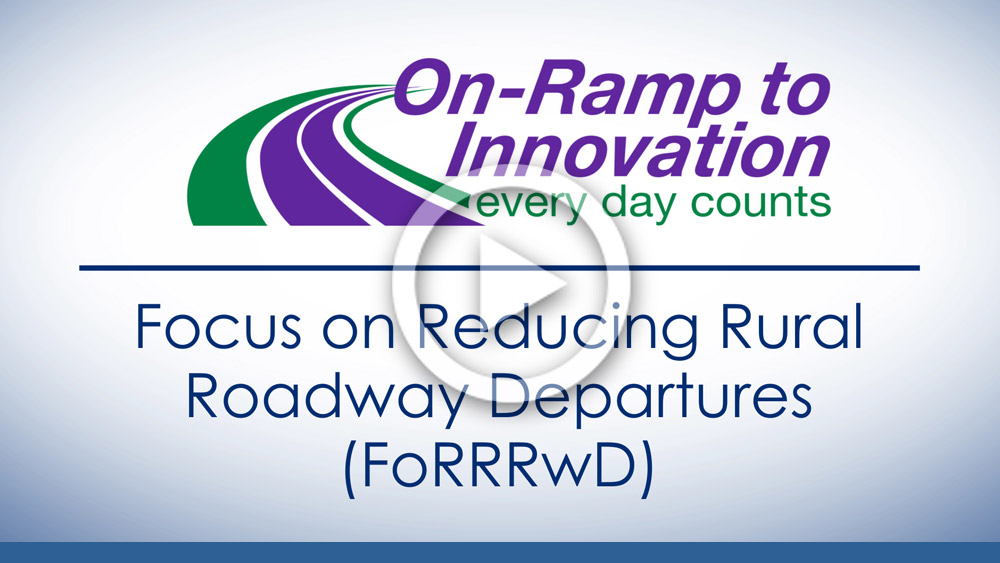September 5, 2019
Innovation of the Month:
Focus on Reducing Rural Roadway Departures
Thirty people will die today, and every day, in a rural roadway departure—accounting for one third of U.S. traffic fatalities. The Focus on Reducing Rural Roadway Departures (FoRRRwD) EDC initiative aims to provide technical assistance and training to States, counties, parishes, townships, and other local agencies across the country to address this deadly problem. This is accomplished through FoRRRwD's four pillars.
The first pillar is recognizing that roadway departures happen on all public roads. Up to half of roadway departure deaths happen on locally-owned roads, off the State highway system. This is why the FoRRRwD initiative puts emphasis on helping both local and State agencies.
Another pillar of FoRRRwD is systemic safety analysis to identify locations for safety improvement. The systemic approach identifies locations that are at high risk of serious rural roadway departure crashes. The analysis is based on roadway features that correlate with particular crash types. Then agencies can install countermeasures at multiple locations across the system with those higher-risk features. Essentially, historic crash and roadway data help agencies identify locations with the greatest potential for future crashes. Because roadway departures are scattered across the rural network, the systemic approach is essential, as it involves widely implemented low cost improvements.
Narrowing down probable crash locations and implementing countermeasures, sometimes even before crashes occur, allows agencies to improve rural road safety in a proactive way.
The Minnesota Department of Transportation (MnDOT) used systemic safety analysis as it developed road safety plans for each of the State's 87 counties. Using a process similar to that outlined in the systemic safety project selection tool, MnDOT helped identify high-risk locations in each county. The analysis also identified emphasis areas to significantly reduce the severe and fatal crash types and helped compile a list of potential safety countermeasures. Ultimately, this information helped counties identify low-cost safety projects to implement on a systemic basis, a key objective of the road safety plans.
Next week, we will discuss how to use the results of systemic analysis to develop safety action plans, the third pillar of FoRRRwD.
To learn more about how your State can move FoRRRwD improving driver safety, visit FHWA's FoRRRwD website, watch the spotlight video, or watch the orientation webinar. If you have additional questions, please contact Cate Satterfield with the FHWA Office of Safety or Dick Albin with the FHWA Resource Center.
Georgia Develops Programmatic Agreement to Streamline State and Federal Aid Projects
The Georgia Department of Transportation (GDOT) developed a programmatic agreement (PA) to streamline project reviews under Section 106 of the National Historic Preservation Act, which requires agencies to consider effects of federally funded projects on historic and archaeological resources. GDOT coordinated extensively with the U.S. Army Corps of Engineers, the Georgia State Historic Preservation Office, the Advisory Council on Historic Preservation, and FHWA to develop the PA. The federally recognized Georgia tribes coordinated with these agencies and are invited signatories to the agreement.
The PA consolidates preexisting agreements under one umbrella agreement and serves as a guide when considering projects that affect these resources. Unique to this Section 106 PA is the level of U.S. Army Corps of Engineers' involvement that ensures that the PA language delegates GDOT the authority to use the PA to streamline all Section 106 compliance at GDOT. GDOT expects the PA will improve efficiency by providing a more predictable, transparent process for project review and consultation. The coordination with federal agencies and tribes should streamline delivery of State and federal aid projects.
If you would like to learn more about how your State can develop programmatic agreements like this, please contact David Clarke with the FHWA Office of Project Development and Environmental Review.
Preview the New and Improved Innovator
Innovator is all about keeping you on the cutting edge of the highway industry. That means Innovator itself must continue to evolve. Starting with the November/December issue, Innovator will be on a new web platform, accessible from any device.
Until the official launch, we invite you to have a sneak peek with the current issue! Click here to view Innovator on the new platform.
In this issue:
- Moving FoRRRwD to Reduce Rural Roadway Departures
- States STEP Up to Enhance Pedestrian Safety
- Using Data to Improve Traffic Incident Management
- And more…
Comments? Questions? We'd love your feedback! Drop us a line and let us know what you think.
Read past issues and sign up to receive Innovator by email here, or text "FHWA Innovation" to 468311 to get Innovator on your smartphone.
About EDC
Every Day Counts, a State-based program of the Federal Highway Administration’s Center for Accelerating Innovation, works with State, local, and private sector partners to encourage the adoption of proven technologies and innovations to shorten and enhance project delivery.




